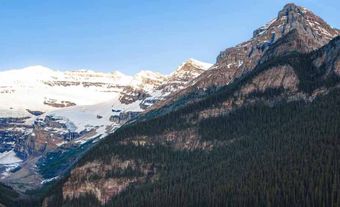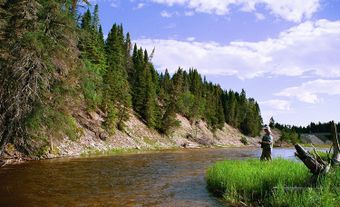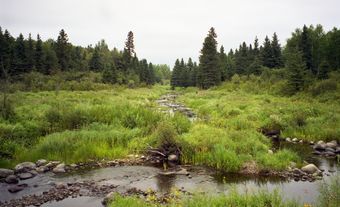Kejimkujik National Park (established 1974, 403.7 km2) is also a national historic site (designated 1995) commemorating over 4,000 years of Indigenous history. The name derives from a Mi'kmaq word referring to the exertion required in paddling across Kejimkujik Lake, which forms the park's centre. Tranquillity is the keynote of this glacier-scarred park situated 160 km southwest of Halifax in southwestern Nova Scotia. Its brooding forests and dark waters are disturbed only by the loon's cry or the swirl of a paddle. In the past, most of the park was logged over and burned, but the ancient character of the forest is once again intact, and scattered stands of ancient hemlocks can still be found.
Wildlife
The wildlife is diverse. The park's marshes, bogs and shallow lakes support more species of reptiles and amphibians than occur anywhere else in Atlantic Canada, including rarities like the ribbon snake and Blanding's turtle. The woods are home to mammals common to Eastern Canada, such as black bears, minks, flying squirrels and red foxes.
A pristine 22 km2 stretch of seacoast on Nova Scotia's south shore was added to the park in 1985. The seaside adjunct is home to the endangered piping plover and also features a large resident population of waterfowl and seals.
History
The area's first inhabitants, the Mi'kmaq, left hundreds of petroglyphs (see Pictographs and Petroglyphs) depicting legends and events on the slate outcrops of Kejimkujik Lake. The waterways linking the Atlantic Ocean and the Bay of Fundy provided the Mi'kmaq and French with a major canoe route, and the park is still a canoeist's paradise. Scottish and Irish immigrants settled as early as the 1760s and wealthy Boston families used the area as a summer retreat in the late 1800s.
In 1993, the park was designated Canada's first Ecological Monitoring and Assessment Network (EMAN) site. Universities, government agencies and international agencies studied a broad spectrum of ecological topics, including the effects of acid rain, forest biodiversity, ozone depletion and habitat fragmentation. Kejimkujik forms part of the core zone of the Southwest Nova Biosphere Reserve (designated 2001).
Present Day
Today, the Kejimkujik National Park and National Historic Site offers a variety of recreational opportunities, such as canoeing, kayaking, hiking, biking, and camping. The site continues to be known for its natural and cultural heritage and its seaside views.
The park also continues to be a site for research, with continued ecological restoration projects and various conservation initiatives taking place on the land.


 Share on Facebook
Share on Facebook Share on X
Share on X Share by Email
Share by Email Share on Google Classroom
Share on Google Classroom



